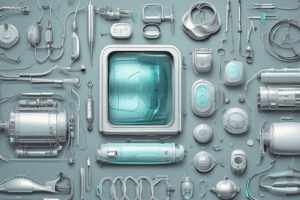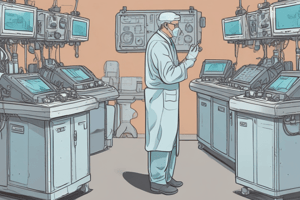Podcast
Questions and Answers
What is the appropriate temperature range for dry heat sterilization?
What is the appropriate temperature range for dry heat sterilization?
- 250-270°C
- 200-220°C
- 100-120°C
- 160-170°C (correct)
Which of the following is a disadvantage of dry heat sterilization?
Which of the following is a disadvantage of dry heat sterilization?
- It is suitable for heat-sensitive instruments.
- It is time-consuming. (correct)
- It cannot sterilize metal instruments.
- It requires specialized facilities.
What type of radiation is used in radiation sterilization methods?
What type of radiation is used in radiation sterilization methods?
- Ultraviolet radiation
- Infrared radiation
- Gamma rays (correct)
- Visible light
During which step of the surgical pack preparation must instruments be checked for damage and function?
During which step of the surgical pack preparation must instruments be checked for damage and function?
Why is it important to group instruments by function during pack assembly?
Why is it important to group instruments by function during pack assembly?
What should be done to prevent moisture from affecting the sterilization process?
What should be done to prevent moisture from affecting the sterilization process?
What does the inclusion of sterilization indicator strips in the pack signify?
What does the inclusion of sterilization indicator strips in the pack signify?
Which of the following is NOT a type of instrument grouping recommended during assembly?
Which of the following is NOT a type of instrument grouping recommended during assembly?
What is the main advantage of double wrapping a surgical pack?
What is the main advantage of double wrapping a surgical pack?
Which technique is essential for ensuring proper steam penetration when wrapping surgical packs?
Which technique is essential for ensuring proper steam penetration when wrapping surgical packs?
What information should be included on the label of a sterilization pack?
What information should be included on the label of a sterilization pack?
What is the recommended action after the sterilization cycle is complete?
What is the recommended action after the sterilization cycle is complete?
Which of the following is NOT a part of the cleaning process for surgical instruments?
Which of the following is NOT a part of the cleaning process for surgical instruments?
What should be considered when loading wrapped packs into a sterilizer?
What should be considered when loading wrapped packs into a sterilizer?
In which environment should sterilized packs be stored?
In which environment should sterilized packs be stored?
What is the purpose of using sterilization indicator tape?
What is the purpose of using sterilization indicator tape?
What is the primary function of external indicators in the sterilization process?
What is the primary function of external indicators in the sterilization process?
Which indicator type provides a measurement of physical parameters during sterilization?
Which indicator type provides a measurement of physical parameters during sterilization?
What do biological indicators confirm in the sterilization process?
What do biological indicators confirm in the sterilization process?
What is the purpose of using chemical indicators in sterilization?
What is the purpose of using chemical indicators in sterilization?
What is the role of High-Efficiency Particulate Air (HEPA) filters in an operating room?
What is the role of High-Efficiency Particulate Air (HEPA) filters in an operating room?
What are the zones in an operating room setup, and which one is the most sterile?
What are the zones in an operating room setup, and which one is the most sterile?
What ensures the sterilization conditions are consistently monitored during a procedure?
What ensures the sterilization conditions are consistently monitored during a procedure?
How are surgical instruments recommended to be organized within the operating room?
How are surgical instruments recommended to be organized within the operating room?
What is the primary purpose of monitoring equipment during surgery?
What is the primary purpose of monitoring equipment during surgery?
Which step is crucial before beginning a surgical procedure?
Which step is crucial before beginning a surgical procedure?
What should be done to prepare the surgical site?
What should be done to prepare the surgical site?
What is the main goal of performing an aseptic technique?
What is the main goal of performing an aseptic technique?
Which of the following actions is part of infection control measures in the operating room?
Which of the following actions is part of infection control measures in the operating room?
Which is a necessary component of postoperative verification?
Which is a necessary component of postoperative verification?
What is the significance of conducting a time-out before incision?
What is the significance of conducting a time-out before incision?
What is essential for documenting during the surgery?
What is essential for documenting during the surgery?
What is the primary purpose of sterilization?
What is the primary purpose of sterilization?
What type of instruments is not suitable for autoclaving?
What type of instruments is not suitable for autoclaving?
Which sterilization method is effective for heat- and moisture-sensitive instruments?
Which sterilization method is effective for heat- and moisture-sensitive instruments?
How long should instruments be immersed in a 2% glutaraldehyde solution for sterilization?
How long should instruments be immersed in a 2% glutaraldehyde solution for sterilization?
What is a disadvantage of using Ethylene Oxide for sterilization?
What is a disadvantage of using Ethylene Oxide for sterilization?
What is the contact time for sterilization using 35% hydrogen peroxide?
What is the contact time for sterilization using 35% hydrogen peroxide?
What is a potential hazard of using cold chemical sterilization?
What is a potential hazard of using cold chemical sterilization?
Which sterilization method utilizes hot air to sterilize instruments?
Which sterilization method utilizes hot air to sterilize instruments?
Flashcards are hidden until you start studying
Study Notes
Definitions
- Sterilization: Process aimed at killing or removing all microorganisms from an object that comes in contact with sterile tissue or the vascular system.
- Disinfection: Eliminates many pathogenic microorganisms on inanimate objects, excluding bacterial spores.
Methods of Sterilization
- Autoclaving (Steam Sterilization): Uses saturated steam at 121-134°C for 15-30 minutes; highly effective but not suitable for heat-sensitive instruments.
- Ethylene Oxide (EtO) Sterilization: Employs ethylene oxide gas at 45-60°C and 10-12 psi; effective for heat-sensitive items but time-consuming and requires ventilation due to toxicity.
- Cold Chemical Sterilization: Utilizes agents like glutaraldehyde and hydrogen peroxide with varying contact times; suitable for heat-sensitive instruments but can leave hazardous residues if not rinsed.
- Dry Heat Sterilization: Involves hot air ovens at 160-170°C for 1-2 hours; suitable for heat-resistant instruments but time-consuming.
- Radiation Sterilization: Uses gamma rays or electron beams; suitable for single-use instruments but expensive and impractical for routine processes.
Surgical Pack Preparation
- Gathering and Sorting: Collect and categorize instruments by type and size to streamline cleaning.
- Cleaning and Decontamination: Use brushes and detergents to remove debris, followed by rinsing with distilled water for thorough cleanliness.
- Assembly of the Surgical Pack: Organize instruments functionally, keeping sharp instruments protected and using sterilization trays.
- Wrapping the Surgical Pack: Securely wrap using sterile materials, employing proper folding techniques to ensure effective sterilization penetration.
- Sealing and Labeling: Use indicator tape for sealing and label with contents and sterilization details.
- Sterilization Process: Load packs into sterilizer with space for steam circulation; monitor sterilization cycle parameters.
- Post-Sterilization Handling: Cool packs in a sterile environment, inspect indicators to confirm successful sterilization, and check integrity of wraps.
- Storage: Store sterilized packs in a clean, dry area; implement first-in, first-out (FIFO) system for usage.
Maintenance of Surgical Equipment
- Cleaning: Immediate rinsing of instruments after use, employing enzymatic cleaners or ultrasonic cleaners for thorough cleaning.
- Monitoring Sterilization: Use external indicators for visual verification, internal indicators for confirming sterilization agent penetration, and mechanical indicators for recording parameters like temperature and pressure.
Operating Room Setup
- Layout and Design: Establish a sterile field with distinct zones, ensuring proper lighting and ventilation with HEPA filters.
- Equipment and Instruments: Organize surgical instruments and monitor vital signs equipment for easy access; prepare anesthesia and suction devices.
- Patient Preparation: Secure and cleanse the surgical site, using sterile drapes to maintain a sterile field.
Operating Room Protocols
- Aseptic Technique: Perform thorough surgical scrubs before gloving; avoid non-sterile surface contact.
- Surgical Safety Checklist: Confirm patient identity and surgical site; conduct a time-out before incision.
- Infection Control: Adhere to strict cleaning and disinfecting protocols; wear appropriate PPE.
- Patient Safety: Monitor patient’s vital signs continuously; maintain clear communication within the surgical team.
- Documentation: Maintain records of patient data, procedures, and instrument counts to ensure nothing is left in the patient.
Studying That Suits You
Use AI to generate personalized quizzes and flashcards to suit your learning preferences.




